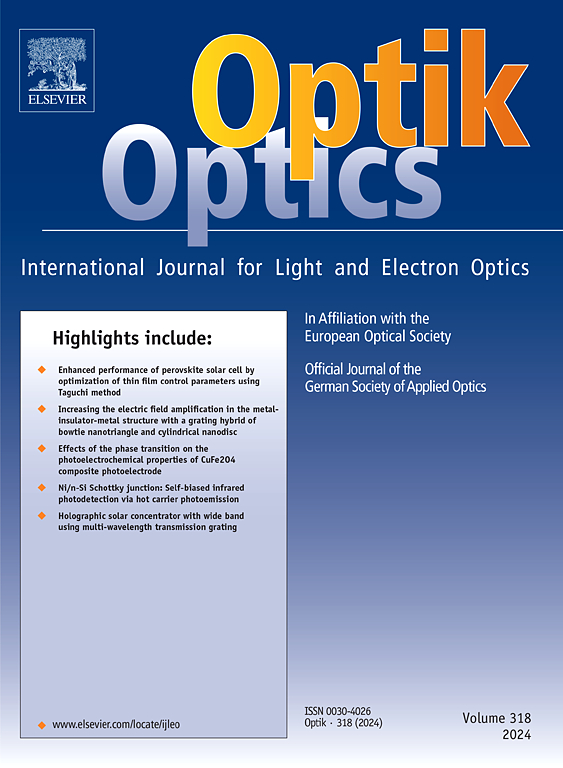用于多种疾病检测的太赫兹生物传感技术:癌症、疟疾、芽孢杆菌病毒和结核病诊断
IF 3.1
3区 物理与天体物理
Q2 Engineering
引用次数: 0
摘要
提出了一种用于多疾病诊断的超灵敏窄带超材料(MTM)生物传感器,并通过仿真研究进行了评价。所提出的传感器包含一个聚酰亚胺介电层,该介电层封闭在铝基和顶部的金属贴片之间。将分析物样品涂在金属贴片上,产生峰值共振,显示出显著的吸收。被分析物质的光学特性影响峰值响应频率。因此,所设计的传感器可以有效地对癌症、疟疾、芽孢杆菌病毒、肺结核等多种疾病进行诊断。采用全矢量有限元法研究了结构特性对传感器灵敏度的影响,并对传感器的灵敏度进行了优化。该传感器在2.054 THz处达到最佳吸收,吸收效率为96.9%。所提出的传感器对Jurkat癌细胞的灵敏度提高了5002 GHz/RIU,大大超过了现有研究报告的灵敏度,此外,在1.0太赫兹到3.0太赫兹的频率范围内,质量因子为26.2。此外,吸收器保持稳定的性能,入射角高达80°,达到超过85%的吸收率。此外,该传感器不受极化的影响。该吸收器的主要特点包括结构紧凑,设计简单,可调谐,极化弹性,极窄的吸收带宽(BW),出色的灵敏度,优异的性能因数(FOM)和卓越的质量因子(Q),使其非常适用于检测:癌症,疟疾,芽孢杆菌病毒和结核病诊断。本文章由计算机程序翻译,如有差异,请以英文原文为准。
Terahertz-based biosensing technology for multi-disease detection: Cancer, Malaria, Bacillus Virus, and Tuberculosis diagnosis
An exceptionally sensitive narrowband metamaterial (MTM) biosensor for multi-disease diagnosis is proposed and evaluated through simulation studies. The presented sensor incorporates a polyimide dielectric layer enclosed between an aluminum base and metallic patches on top. The analyte sample is applied over the metallic patch, resulting in a peak resonance exhibiting significant absorption. The optical characteristics of the analyzed substance influence the peak response frequencies. Consequently, the designed sensor can effectively among various types of multi-disease detection: Cancer, Malaria, Bacillus Virus, and Tuberculosis Diagnosis. The full vector finite element method (FEM) is employed to investigate the impact of the structural characteristics and to optimize the sensitivity of the sensor. The sensor achieves optimal absorption at 2.054 THz, with an absorption efficiency of 96.9%. The presented sensor exhibits an elevated sensitivity of 5002 GHz/RIU for Jurkat cancerous cells, significantly surpassing those reported in existing studies, in addition to a quality factor of 26.2 within the range of frequencies of 1.0 THz to 3.0 THz. Moreover, the absorber maintains stable performance at incidence angles up to 80°, achieving an absorptivity exceeding 85%. In addition, the proposed sensor remains unaffected by polarization. Key characteristics of the absorber include its compact structure, simplistic design, tuneability, polarization resilience, extremely narrow absorption bandwidth (BW), outstanding sensitivity, superior figure of merit (FOM), and remarkable quality factor (Q), making it highly suitable for applications such as detection: Cancer, Malaria, Bacillus Virus, and Tuberculosis Diagnosis.
求助全文
通过发布文献求助,成功后即可免费获取论文全文。
去求助
来源期刊

Optik
物理-光学
CiteScore
6.90
自引率
12.90%
发文量
1471
审稿时长
46 days
期刊介绍:
Optik publishes articles on all subjects related to light and electron optics and offers a survey on the state of research and technical development within the following fields:
Optics:
-Optics design, geometrical and beam optics, wave optics-
Optical and micro-optical components, diffractive optics, devices and systems-
Photoelectric and optoelectronic devices-
Optical properties of materials, nonlinear optics, wave propagation and transmission in homogeneous and inhomogeneous materials-
Information optics, image formation and processing, holographic techniques, microscopes and spectrometer techniques, and image analysis-
Optical testing and measuring techniques-
Optical communication and computing-
Physiological optics-
As well as other related topics.
 求助内容:
求助内容: 应助结果提醒方式:
应助结果提醒方式:


